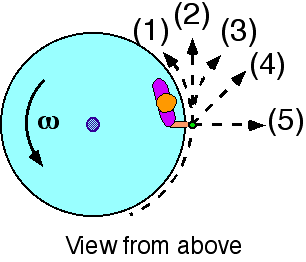Goal: Hone the concept of angular velocity and link to rotational inertia and angular momentum
Source: UMPERG-ctqpe122

A child is standing at the rim of a
rotating disk holding a rock. The disk rotates without friction. The
rock is dropped at the instant shown. As a result of dropping the rock,
what happens to the angular velocity of the child and disk?
- The angular velocity increases.
- The angular velocity stays the same.
- The angular velocity decreases.
- cannot be determined
Commentary:
Answer
(2) is the correct response if the rock is simply dropped. However, some
students selecting this choice may think that the angular velocity is
maintained by some external agency. Students selecting answer (1) are
likely misapplying conservation of angular momentum.
Background
This question is useful for revealing whether students understand the
concept of moment of inertia and its relationship to angular momentum.
Many students reason that after the rock is dropped, the moment of
inertia is smaller and the angular velocity must increase to conserve
angular momentum.
RevealingQ
When dropped, does the rock have angular velocity? Just before being
dropped does the rock have angular momentum? Just after being dropped
does the rock have angular momentum?
Suggestions
It is possible to do a traditional demonstration of the role of moment
of inertia in angular momentum and then just drop the weights when arms
are extended.